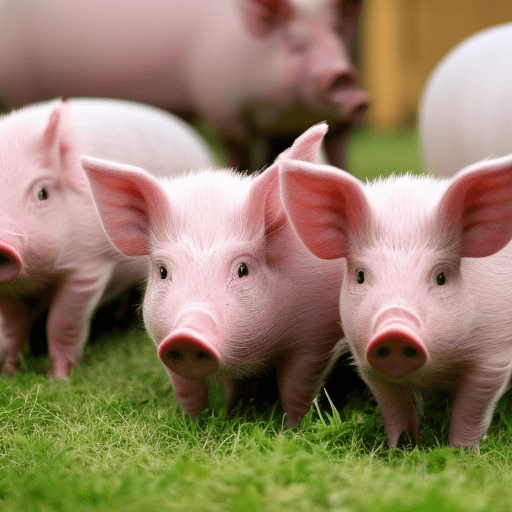There is a lot of confusion surrounding the topic of hogs vs pigs.
Many people use the terms interchangeably, but there is a big difference between the two animals.
In this blog post, we will discuss the differences between hogs and pigs and provide some information about each animal.
We will also discuss which animal is better for farming purposes. Stay tuned to learn more!

The difference between hogs and pigs is that hogs are bred to be larger, while pigs are bred to be smaller.
Hogs are members of the pig family, but they are not the same as pigs.
Pigs are also considered to be less intelligent than hogs.
Both animals are used for their meat, but hog meat is more widely available.
The term “pig” can also refer to wild boar, which is a different animal altogether.
What are the differences between hogs and pigs?
While hogs and pigs may look similar, there are actually several important differences between these two animals.
For one, hogs are typically much larger than pigs.
They also have different diets; hogs are omnivorous, while pigs are primarily herbivorous.
In addition, hogs are typically bred for their meat, while pigs are bred for both their meat and their ability to act as working animals.
Finally, hogs typically have longer snouts than pigs, which gives them a better sense of smell.
However, both hogs and pigs are intelligent animals that can be trained to perform a variety of tasks.
Which animal is better for farming purposes, hogs or pigs?
When it comes to farming, both hogs and pigs have their own distinct advantages.

Hogs are typically larger and more resistant to disease, while pigs tend to be more docile and easier to handle.
However, pigs also reproduce more quickly and require less food, making them more efficient at converting feed into meat.
For these reasons, pigs are generally considered to be better for farming purposes than hogs.
That said, the best animal for any given farm depends on the specific conditions and needs of the operation.
Ultimately, it is up to the farmer to decide which type of animal is best suited for their particular farm.
How are hogs vs pigs raised?
Hogs and pigs are both raised for their meat, but there are some important differences between the two.

Hogs are generally larger than pigs, and they have slightly different body shapes.
Hogs also have longer snouts, which helps them root around for food.
Pigs, on the other hand, have shorter snouts and are more likely to scavenge for food.
Hogs are also typically raised in larger groups than pigs, which can make them more aggressive.
Pigs, on the other hand, are usually kept in smaller groups or even individually.
As a result, they tend to be more docile than hogs.
Both pigs and hogs are intelligent animals, but pigs are generally considered to be more intelligent than hogs.
This difference is likely due to the fact that pigs are kept in smaller groups, which allows them to form stronger bonds with each other and with their handlers.
What do hogs vs pigs eat?
Hogs and pigs are omnivores, which means that they eat both plants and animals.
Some common foods that hogs and pigs eat include roots, fruits, berries, nuts, insects, small mammals, and carrion.
Pigs also eat garbage and other scavenged materials, which is why they are often considered to be dirty animals.
Hogs are typically raised for meat production, while pigs are used for both meat production and as working animals.
Consequently, the diets of hogs and pigs can vary significantly depending on their specific purpose.
For example, hogs that are being raised for meat may be fed a diet of corn and soybeans, while working pigs may eat mostly root vegetables.
Ultimately, hogs and pigs will eat a wide variety of foods depending on their individual needs.
How are hogs and pigs used for meat?
Hogs and pigs are popular animals for meat production due to their high rate of reproduction and rapid growth.

Over half of the world’s pork supply comes from hogs, and they are commonly used in sausage, ham, and bacon.
In addition to being raised for meat, hogs are also used for their fat, which is rendered into lard, and their skin, which is used for leather.
Pigs are also a popular choice for biomedical research, as their physiology is similar to that of humans.
As a result, hogs play an important role in the meat industry as well as in scientific research.
What are the benefits of raising hogs and pigs?
There are many benefits to raising hogs and pigs.
For one, they are relatively easy to care for and require little space.
They are also a versatile source of food, providing both meat and fat.
In addition, hogs and pigs can be used for their manure, which is an excellent source of fertilizer.
Raising hogs and pigs can also be a profitable venture.
They are relatively low-maintenance animals, and their meat is in high demand.
Consequently, hog and pig farmers can generate a significant income from selling their animals.
In addition, the manure produced by hogs and pigs can be sold as fertilizer, providing another source of revenue.
Overall, there are many advantages to raising hogs and pigs.
They are easy to care for, provide a valuable source of food, and can be quite profitable.
Consequently, hog and pig farming is an excellent way to support oneself and one’s family.
So, next time you’re talking about these two animals, make sure to use the correct term!
Article Sources
Jacks of Science sources the most authoritative, trustworthy, and highly recognized institutions for our article research. Learn more about our Editorial Teams process and diligence in verifying the accuracy of every article we publish.
